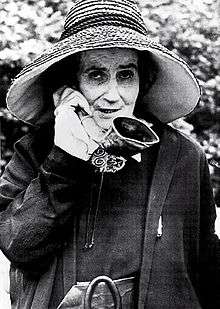Louise Elisabeth de Meuron

Louise Elisabeth de Meuron, better known as Madame de Meuron (22 August 1882 – 22 May 1980), was an aristocrat and well-known eccentric personality in the city of Bern, Switzerland.
Family and life
She was born the daughter of Anna (née von Wattenwyl) and Ludwig von Tscharner in the family town residence (today the cantonal finance department) on the Münsterplatz in the city of Bern. Her family refused permission for her marriage to the man she loved and she was obliged to marry her cousin, Frédéric-Alphonse de Meuron, in 1905. The marriage ended in divorce in 1923. Her father, a doctor of philosophy and colonel in the engineers, died in 1927. Her son committed suicide in 1939 and her daughter emigrated to Morocco.
She owned several houses in the Bernese old town as well as the alpine meadowland known as Rämisgummen above Eggiwil. In addition, she inherited Amsoldingen Castle from her father and Rümligen Castle from her mother; the latter became her main residence for many years. She died just before the age of 98 in the Riggisberg borough hospital and lies buried in the cemetery at Gerzensee.
Following the tragedy of her son's suicide in 1939, she dressed in mourning for the rest of her life. She devoted herself to philosophy and wrote innumerable letters. She regularly staged the famous show jumping event, the Concours hippique, in Rümligen, and was noted for her imperious manner. The lifestyle of Elisabeth de Meuron gave rise to innumerable anecdotes which, however, while having substance, should not all be taken at face value. Her reputation as a Bernese original was derived not only from her anachronistic appearance – old fashioned widow's weeds, walking stick and ear trumpet (So that I hear only what I want to hear)[1] – but also on account of her eccentric behaviour. She was often seen in Bern city centre accompanied by her Russian greyhounds. Her staff were allowed to park her car anywhere and if a policeman came along, she would explain: That stays here![2] She never bought a tram ticket because, as she said: I was here before the tram! [3] She would ask total strangers: Are you someone or do you get a salary?[4] When a farmer wanted to sit on the Frisching family pew, she put him right, saying: Up in heaven we'll all be equal, but in the meantime down here, we'll have a bit of discipline.[5] And once when a female vagrant (or as she put it: crazy little beggar woman)[6] was caught stealing fruit from her castle grounds, she locked her up in the coach house for two days. When charged with false imprisonment, she produced in court a document dating from the Middle Ages which authorised the owner of Rümligen Castle to administer low justice. She was let off with a small fine and a lecture on current law.
Original Swiss German
- ↑ So ghör i nume was i wott!
- ↑ Me laht das da!
- ↑ I bi vor em Tram da gsi!
- ↑ Syt Dir öpper oder nämet Dir Lohn?
- ↑ Im Himmel obe sy mer mynetwäge alli glych, aber hie unde wei mer einschtwyle no Ornig ha!
- ↑ schturms Froueli, Tschaaggeli
References
- Susy Langhans-Maync: Madame de ... Viktoria, Ostermundigen 1971; 11. A. 1984, ISBN 3-85958-007-8 (in Bernese German)
- Rosmarie Borle et al.: Madame de Meuron 22. August 1882 – 22. Mai 1980. Ein Erinnerungsalbum. Erpf, Bern 1980, ISBN 3-256-00019-3
- Michael Stettler: Machs na. Figuren und Exempel. Stämpfli, Bern 1981, ISBN 3-7272-0049-9
- Hans A. Jenny: Schweizer Originale. Porträts helvetischer Individuen (= Band 1). Nebelspalter, Rorschach 1991, S. 76–79, ISBN 3-85819-158-2
- Guy de Meuron: Histoire d’une famille neuchâteloise. Attinger, Hauterive 1991, ISBN 2-88256-050-8
External links
- Meuron, Elisabeth de in German, French and Italian in the online Historical Dictionary of Switzerland.
The above is a translation of the article in the German Wikipedia at de:Louise Elisabeth de Meuron
|